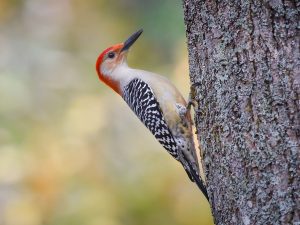
Visit any wooded neighborhood around Annapolis or along the South River, and you’re likely to hear it before you see it—a rolling “churr-churr-churr” call that carries through the trees. Then a flash of black-and-white barred back and a blaze of crimson on the head as a medium-sized woodpecker moves confidently up a tree trunk or swoops between oaks in an undulating flight pattern. This is the Red-Bellied Woodpecker (Melanerpes carolinus), one of the most successful and adaptable birds in the Chesapeake Bay region, whose increasing presence tells a remarkable story of resilience and adaptation to our changing landscape. We welcome you on one of our Storyteller Cruises – Natural History Charters(Half-Day or Full-Day) where we routinely visit prime forest habitat on the South River, Harness Creek and Rhode River.
The Bird with the Misleading Name
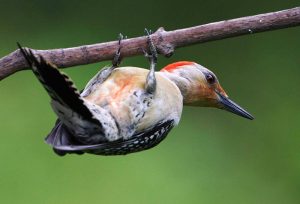
Despite its name, the red-bellied woodpecker’s most striking feature isn’t its belly—which sports only a faint wash of pinkish-red plumage often difficult to see in field conditions—but rather its brilliant red cap and nape. This naming confusion leads to frequent misidentifications among beginning birders, who might expect a more prominent red belly based on the name alone.
Males display a complete crimson cap from bill to nape, while females show red only on the nape, with a grayish crown. Both sexes feature the distinctive black-and-white “zebra” pattern on their backs—a bold barring that immediately distinguishes them from other woodpeckers common around the South River. At about 9 inches long, they’re considerably larger than downy woodpeckers but smaller than the crow-sized pileated woodpeckers that also inhabit the region’s mature forests.
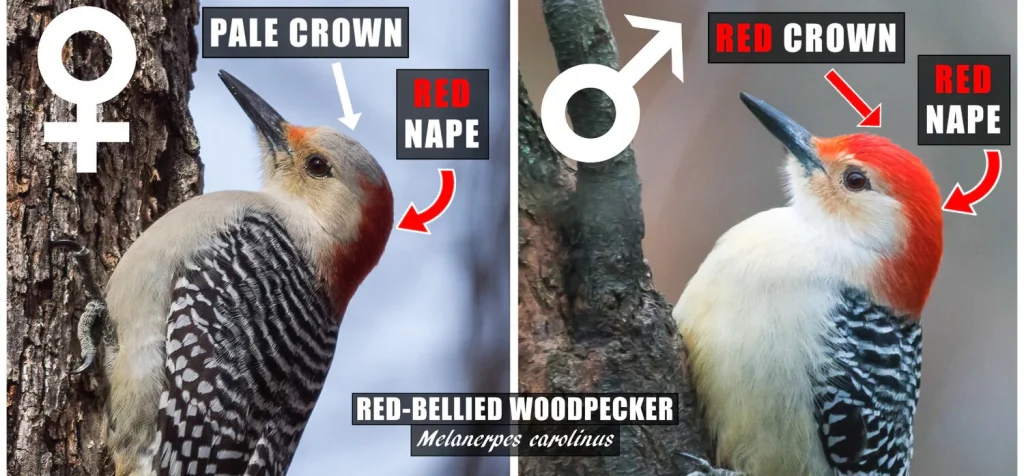
When in flight between the oaks and hickories that dominate the woodlands around Annapolis, these woodpeckers display white patches on their wings and the characteristic undulating flight pattern of their family—a series of flaps followed by a brief folding of the wings that creates a roller-coaster-like trajectory through the forest canopy.
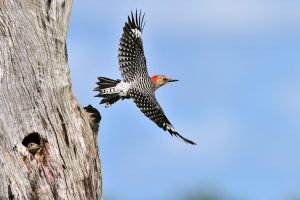
A Species on the Move
One of the most fascinating aspects of red-bellied woodpeckers in the Chesapeake region is their significant range expansion over recent decades. Historical records suggest these birds were uncommon around Annapolis and the northern Chesapeake until the mid-20th century, with their primary range centered in the southeastern United States.
Since the 1950s, they’ve steadily expanded northward, becoming one of the most common woodpeckers throughout Maryland. Citizen science data from projects like the Christmas Bird Count and Maryland Breeding Bird Atlas confirm this dramatic range expansion, with numbers around the South River and greater Annapolis area increasing by approximately 5% annually over recent decades.
Climate change likely plays a role in this expansion, as warming winters make northern territories more hospitable. However, the birds’ remarkable adaptability to suburban environments has been equally important. Unlike some woodland specialists that retreat from development, red-bellied woodpeckers have thrived in the forest fragments, parklands, and even well-wooded suburban neighborhoods that characterize much of the South River watershed.
Ecological Opportunists in Chesapeake Forests
Red-bellied woodpeckers embody ecological opportunism in the best sense of the term. Their diet is remarkably diverse, shifting seasonally to take advantage of whatever resources are most abundant in the forests and neighborhoods surrounding the South River.
In spring and summer, they consume significant quantities of insects gleaned from tree bark or captured in short flights from perches. Their long, barbed tongues—which can extend nearly two inches beyond the tip of their bill—allow them to extract prey from crevices other birds cannot access. This insectivorous tendency makes them valuable allies for maintaining forest health and even controlling garden pests in suburban environments.
As summer transitions to fall, their diet shifts dramatically toward fruits and nuts. Throughout the woodlands of Quiet Waters Park, Beverly Triton Nature Park, and residential areas along the South River, red-bellied woodpeckers feast on wild cherries, dogwood berries, poison ivy fruits (a particular favorite), and the abundant acorns produced by the region’s many oak species. They’re among the few birds capable of consuming whole acorns, which they often cache in bark crevices for later consumption—occasionally “planting” future trees in the process.
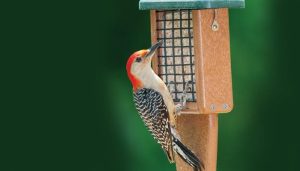
Perhaps most distinctive is their behavior at our backyard bird feeders. They readily consume sunflower seeds, peanuts, and suet, approaching feeders with a confidence that delights wildlife enthusiasts. Their ability to grip vertical surfaces allows them to access feeder types that exclude many other species, while their relatively large size and assertive demeanor often grant them priority at feeding stations.
Life Cycle Along the South River
The annual rhythm of red-bellied woodpecker life aligns with the seasonal patterns of the Chesapeake region. Unlike migratory birds that depart for winter, these woodpeckers maintain territories year-round in the forests and neighborhoods surrounding the South River, providing welcome flashes of color and activity even during the bleakest winter days.
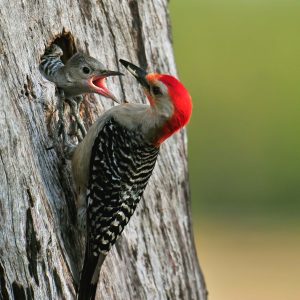
Courtship begins in late winter, when pairs establish or reaffirm bonds through distinctive displays that include mutual tapping on resonant branches, crest-raising, and synchronized movements around potential nest sites. Their drumming—less impressive than the powerful tattoos of pileated woodpeckers but still distinctly woodpecker-like—serves both as territorial announcement and pair bonding activity.
Nesting occurs in cavities that the birds excavate in dead limbs or trunks, typically 15-40 feet above ground. Around Annapolis, favored nest trees include oaks, maples, and sycamores with decaying sections that facilitate excavation while maintaining structural integrity. The same territories may be used for years, though pairs typically excavate new nest cavities each season, creating valuable habitat for secondary cavity-nesters in subsequent years.
Female woodpeckers typically lay 4-5 eggs in April or May, with both parents sharing incubation duties for approximately two weeks. After hatching, young woodpeckers remain in the nest cavity for about 26-28 days before fledging. Attentive observers along woodland trails in places like Smithsonian Environmental Research Center or around neighborhood yards may witness the industrious parents making frequent feeding trips to nourish their growing youngsters.
Even after fledging, juvenile woodpeckers remain with their parents for several weeks, learning specialized foraging techniques before dispersing to establish their own territories. This extended family period represents an important learning phase that contributes to the species’ successful adaptation to varied habitats throughout the Chesapeake watershed.
Where to Find Red-bellied Woodpeckers With Island Chill Yacht Charters
For nature enthusiasts hoping to observe these charismatic birds around Annapolis and the South River, opportunities abound in almost any wooded setting. We welcome you on one of our Storyteller Cruises – Natural History Charters(Half-Day or Full-Day). We routinely cover close pass-bys of prime forest habitat on the South River, Harness Creek and Rhode River.
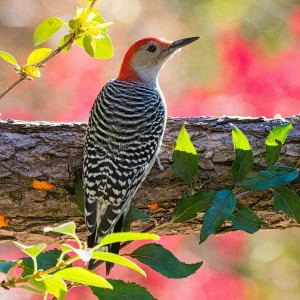
Several locations offer particularly reliable viewing:
- Quiet Waters Park – The mature forest sections on Harness Creek off the South River contain numerous territories, with birds frequently seen from woodland trails
- Historic London Town and Gardens – The preserved woodland along the South River hosts several pairs that are accustomed to human presence
- Smithsonian Environmental Research Center – A diverse forest habitat on the Rhode River with abundant woodpecker activity
- Beverly Triton Nature Park – Between the South and Rhode Rivers, the maritime forest supports resident pairs that can be spotted year-round
- Almost any wooded neighborhood – Unlike some forest specialists, red-bellied woodpeckers readily adapt to suburban environments with mature trees
The birds are active year-round, though they become particularly visible in winter when bare branches make their colorful plumage more conspicuous. Listen for their distinctive rolling “churr” call to locate them, then scan nearby trunks and branches for their distinctive zebra-backed pattern and red head markings.
For backyard birders hoping to attract these colorful visitors to their own properties, feeding stations offering suet, sunflower seeds, and peanuts prove particularly effective. Platform feeders or sturdy hanging feeders that accommodate their size work best. Maintaining mature trees, especially oaks, on the property further enhances habitat quality for these and other woodpeckers.
Ecological Relationships and Forest Health
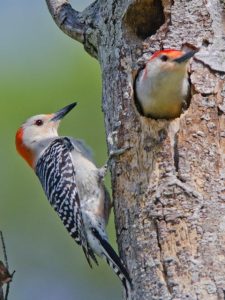
Red-bellied woodpeckers serve several important ecological functions in the forests surrounding the South River and throughout the Chesapeake watershed. Their cavity-excavating behavior creates essential nesting sites for numerous secondary cavity-nesters, including chickadees, titmice, great crested flycatchers, and flying squirrels—species that cannot create their own cavities but depend on existing ones for reproduction.
As predators of wood-boring insects, including some invasive beetle species, these woodpeckers contribute to forest health by controlling potential pest populations. Research conducted at the University of Maryland has documented their consumption of emerald ash borer larvae—a destructive invasive insect threatening ash trees throughout the Chesapeake watershed. While they cannot prevent the spread of such pests entirely, their predation represents one natural check on proliferation.
Their seed-caching behavior also contributes to forest regeneration. Studies of marked acorns have demonstrated that woodpeckers often forget some percentage of their cached seeds, effectively planting them in locations favorable for germination. This process, known as scatter-hoarding, helps maintain oak dominance in Chesapeake forests—a particularly valuable ecological service given the importance of oaks as keystone species in regional ecosystems.
Coexistence with Humans along the Chesapeake
Unlike some wildlife species that have declined with suburban development, red-bellied woodpeckers have found ways to thrive in the human-modified landscape around Annapolis and the South River. Their success story offers lessons in wildlife adaptability and human-wildlife coexistence.
The birds readily utilize artificial structures when natural options are limited. Throughout communities surrounding the South River, red-bellied woodpeckers occasionally excavate cavities in wooden utility poles, fence posts, or even the cedar siding of homes—behaviors that can create conflicts with property owners. However, the provision of nest boxes specifically designed for woodpeckers can redirect this behavior while maintaining the ecological benefits of their presence.
These woodpeckers also make use of human-created food sources beyond traditional feeders. Community parks like Quiet Waters maintain brush piles from trail maintenance that attract insects woodpeckers readily exploit. Golf courses along the South River, when managed with wildlife in mind, can provide excellent woodpecker habitat, especially when dead trees are left standing in out-of-play areas.
Conservation Status and Outlook
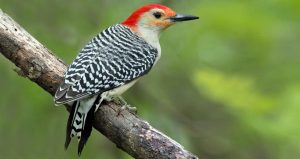
Unlike many bird species in the Chesapeake region that face population declines, red-bellied woodpeckers have increased substantially in recent decades. According to Breeding Bird Survey data, their population in Maryland has grown by approximately 80% since the 1970s, with particularly strong increases in suburban environments like those surrounding Annapolis and the South River.
This success reflects both their adaptability and the maturation of second-growth forests throughout the watershed. As young forests have aged, they’ve developed more of the dead limbs and trunks these woodpeckers require for nesting and foraging. Concurrently, many suburban developments have grown more tree cover as landscaping has matured, creating additional habitat in previously unsuitable areas.
Climate change may further benefit this species in the short term, as milder winters reduce cold-weather mortality and longer growing seasons increase food availability. However, the same climate trends may eventually alter forest composition in ways that affect habitat quality over longer timeframes. Monitoring programs coordinated by organizations like the Maryland Ornithological Society track these population trends, providing valuable data for conservation planning.
While red-bellied woodpeckers face fewer conservation concerns than many bird species, they still benefit from initiatives that maintain forest health and connectivity throughout the Chesapeake watershed. Anne Arundel County’s Forest Conservation Program, which requires mitigation for forest losses due to development, helps maintain the woodland habitat these birds require. Similarly, backyard habitat certification programs encourage private landowners to manage their properties in wildlife-friendly ways.
A Bridge Species for Conservation Awareness
Conservation biologists sometimes refer to charismatic, easily observable wildlife as “bridge species”—creatures that help connect people emotionally to broader environmental concerns. Red-bellied woodpeckers serve this role admirably in communities surrounding the South River and throughout the Chesapeake watershed.
Their willingness to visit backyard feeders brings them into close contact with people who might otherwise have limited wildlife experiences. Their distinctive appearance and engaging behaviors make them memorable, while their year-round presence allows for ongoing connection. For many children growing up in Annapolis neighborhoods, red-bellied woodpeckers may represent their first identified bird beyond common species like robins or blue jays.
Environmental education programs at facilities like Arlington Echo Outdoor Education Center and Jug Bay Wetlands Sanctuary often highlight these woodpeckers as examples of successful adaptation to human-modified landscapes. By understanding how and why these birds thrive, students gain insights into broader ecological principles and conservation needs.
The Sound of Chesapeake Woodlands
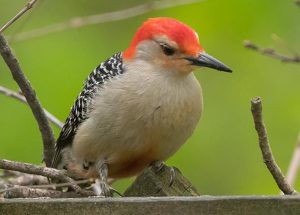
Perhaps the greatest gift red-bellied woodpeckers offer residents of the South River watershed is their consistent, vibrant presence throughout the seasons. When winter grays the landscape and many birds have departed for southern climes, their rolling calls and brilliant plumage bring welcome color and activity to forest edges and backyard trees. In spring, their drumming announces the renewal of the breeding cycle. Summer finds them industriously feeding young, while autumn sees them caching acorns for the coming winter.
This year-round presence creates opportunities for ongoing connection with natural cycles that might otherwise be missed in our increasingly indoor-focused lives. For residents of communities like Hillsmere Shores, Londontowne, Edgewater, and other neighborhoods surrounding the South River, the familiar sight of a red-bellied woodpecker working its way up a backyard oak serves as a living reminder that we share our spaces with wild neighbors deserving of consideration and protection.
The next time you hear that distinctive “churr” call while walking a trail at Quiet Waters Park or while enjoying coffee on your deck overlooking the South River, take a moment to locate the colorful architect of that sound. In its adaptive success and vibrant presence, you’re witnessing not only a biological marvel but also a hopeful indicator that with proper stewardship, wildlife can continue to find niches even in the developed landscapes surrounding the nation’s largest estuary.
As local naturalist have noted: “The persistence of creatures like the red-bellied woodpecker in our everyday environments doesn’t happen by accident—it happens because enough people care about maintaining the habitat these birds need, even in our own backyards. They remind us that conservation isn’t just something that happens in distant wilderness, but in the spaces we inhabit every day.”
